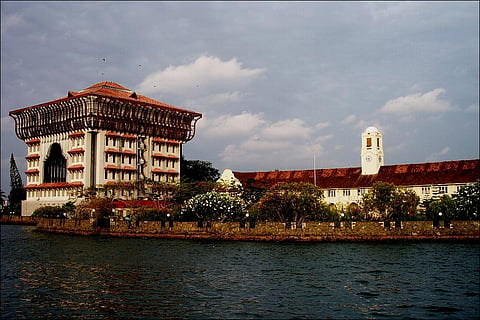

As Vizhinjam port’s formal inauguration by Prime Minister Narendra Modi is just a few days away, a forthcoming book offers a timely counter-narrative to growing speculation in mainstream and social media about the fate of Vallarpadam International Container Transshipment Terminal (ICTT).
Titled Notes from Willingdon Island: The Past, the Present, and the Future of Cochin Port and Its Hinterland, the book is authored by N. Ramachandran, former chairman of Cochin Port Trust. It presents a compelling case for a collaborative, rather than competitive, approach to port development in India.
Ramachandran challenges the notion that Vizhinjam’s emergence diminishes Vallarpadam’s relevance. He contends that both ports are not only necessary, but also serve distinct and complementary roles in India’s maritime ecosystem. Vizhinjam, with its natural deep draft and proximity to international shipping lanes, is ideally positioned to attract transshipment traffic currently handled by Colombo, Singapore, or Dubai. Meanwhile, Vallarpadam remains critical as a gateway port for southern India’s hinterland, supporting regional and coastal trade, direct mainline services, and limited transshipment cargo.
The author points to India’s underwhelming performance in global port metrics—handling just 20 million TEUs in 2024, compared to China’s staggering 330 million—as evidence of the urgent need for a dramatic expansion of port infrastructure. “India needs not just a Vizhinjam or a Vallarpadam,” Ramachandran argues, “but many more of both.”
Blending memoir, institutional history, public policy analysis, and strategic foresight, Notes from Willingdon Island provides an insider’s account of Cochin Port’s dramatic transformation during the early 2000s. Ramachandran recounts how the port, once a sluggish and heavily unionised institution, evolved into a modern, tech-driven logistics hub. He details how his team implemented India’s first fully digital port management system—E-Thuramugham—streamlining workflows and revolutionising customer experience.
The book also explores the construction of the Vallarpadam ICTT, the LNG terminal, national highway and rail linkages, and other major infrastructure projects, all delivered within five years without delays or cost overruns. This rapid progress, Ramachandran notes, was achieved despite constrained finances and considerable bureaucratic and logistical challenges.
A recurring theme in the book is the bold labour reforms undertaken at Cochin Port. Ramachandran candidly reflects on the dilemmas faced by public officials in entrenched environments: whether to accommodate outdated practices for short-term peace, or confront them and risk backlash. Choosing the latter, he pushed through labour rationalisation and digital transparency, with support from successive governments and key stakeholders. The resulting institutional reforms are now embedded in the port’s operational framework.
The author, from his long experience, critiques the regressive labour practices such as nokku kooli and advocates for responsible trade unionism and cross-party consensus on development. With a mix of wit, candour and urgency, he outlines an ambitious agenda for Kerala’s future—covering everything from coastal shipping and shipbuilding to blue economy tourism and the optimal utilisation of the Cochin LNG terminal.
More than a memoir, Notes from Willingdon Island is a deeply informed account of public sector reform, a case study in leadership under pressure, and a strategic vision for maritime growth. Ramachandran’s unusual career trajectory—from police officer to port chairman—infuses the book with both administrative clarity and a reformer’s zeal.
As Vizhinjam Port takes centre stage in national headlines, the book serves as a reminder that Kerala’s maritime future need not be a zero-sum game. Instead, the book calls for an expansive, inclusive vision that leverages India’s 7,500-kilometre coastline and strategic maritime geography. With Kerala’s long coastline and skilled workforce, the state is uniquely positioned to lead India’s blue economy renaissance.
( Notes from Willingdon Island: The Past, the Present, and the Future of Cochin Port and Its Hinterland, published by Konark Publishers, is expected to be released shortly.)